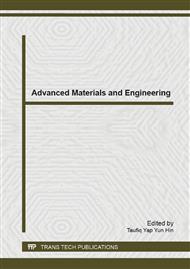p.156
p.161
p.166
p.171
p.175
p.179
p.185
p.190
p.194
Thermal Degradation of Hemp Treated with Guanidine Dihydrogen Phosphate
Abstract:
Hemp was treated with guanidine dihydrogen phosphate [GDP] to impart flame retardance. The thermal degradation of the samples were studied by thermogravimetry (TG) and differential thermal analysis (DTA). The flame retardance was determined by LOI. Morphology of the char structure was studied by SEM to obtain information concerning the thermal degradation mechanism. For hemp treated with GDP, which has higher LOI and char yield values, the oxidative decomposition stages include a decomposition stage at lower temperatures (165-240°C) , leading to more carbonaceous residue and small amount of flammable products to get the good flame retardance. The SEM of the chars of hemp treated with GDP also indicate the structure of the charring layer may increase heat insulation, and protect inner matrix materials.
Info:
Periodical:
Pages:
175-178
Citation:
Online since:
June 2014
Authors:
Keywords:
Price:
Сopyright:
© 2014 Trans Tech Publications Ltd. All Rights Reserved
Share:
Citation:


